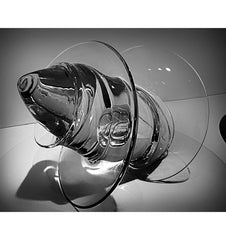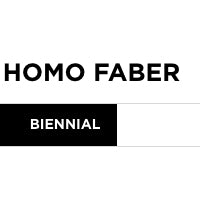
Walter Furlan was born in 1931 in Chioggia, a small town in the southern part of the lagoon of Venice.
At an early age he goes to work in the V.A.M.S.A. glassworks, where he
was apprenticed to Romano Tosi, a master-craftsman, better-known as "Mamaracio". At the end of the Second World War, 1940-1945 Furlan goes to work in the glassworks of Gino Cenedese where he assists Alfredo Barbini and all the old craftsmen of the former V.A.M.S.A. , amongst them "Mamaracio" and Gino Forte known as "Petà".
At the Gino Cenedese glassworks, Furlan learns the technique of sculpting glass " a massello ", which was later his favourite method.
After working on the production of Venetian candelabras, Furlan joins Albino Carrara (also from the V.A.M.S.A factory) at the Ferro & Lazzarini, where Maestro Ineo Fuga, specialist in making Antique Venetian candelabras, is working. Walter Furlan learns from him how to make almost all the models of the famous Venetian candelabras. Later Furlan succeeds Ineo Fuga in the candelabra department of the Ferro and Lazzarini glassworks.
Having become a master-craftsman while still young, Furlan has contacts with artists, and meets Fulvio Bianconi .
At the Ferro & Lazzarini factory, Furlan begins to collaborate with professor Ezio Rizzetto, and their mutual understanding produced artistic works which were exhibited at the early shows at Bevilacqua La Masa. Maestro Furlan has the opportunity to participate in other exhibitions with works of his own creation, obtaining recognition as a Designer.
In 1963 his work is shown at the Murano Glass Exhibition, organised by the Istituto Veneto per il Lavoro: he also participates in the Crafts Exhibition in Reggio Calabria.
In the early 70s, Furlan joins the Seguso Vetri d'Arte glassworks, under the guide of Maestro Angelo Seguso and the Designer Mario Pinsoni, and learns the techniques of "submerged" glass and stylised forms, typical of the designs of professor Favio Poli who was then working for the Seguso Vetri d'Arte, becoming his most reliable interpreter.n 1977 he joins the "first course for artists" organised by the International Glass School, and on this occasion, carries out works by the artists Horst Sobota, Renzo Margonari, and Ghibbe giving proof of his great capacity for interpreting artistic design.
Later, Maestro Furlan participates in the Premio Murano, an event organised by the Abate Zanetti Association; on this occasion he carries out works for Verdiano Marzi, Andrea Pagnacco, Marconi and Laura Santoro. More recently he has carried out works for Lindstrom, Alinari, Barattini, Wagner and Jef Van Reniaout.
At present most of his work is inspired by the fascinating artistic progress of the work of Picasso, expressing in his glass sculptures all the experience acquired during his periods of work with oldmasters.
Walter passed away in 2018.
The works of Walter Furlan are to be found in the best showrooms specialised in the sale of sculpture in glass.
credits: http://www.effe-vetreria-artistica.it
Here is the obituary published in the Venice newspaper "LA Nuova":
MURANO. At 86, the Picasso of glassmakers, the master Walter Furlan, passed away. In fact, he had been nicknamed in the environment, for his great ability to work the raw material famous on the island, taking inspiration from famous artists such as Picasso and Mirò.
Bright colors were his trademark, that intense play between reds and yellows that made his works in solid glass unique and captivating. Last Friday his death overwhelmed him in his bed at the Civil Hospital of Venice, and today at 11 am he will be given the last farewell in the church of San Pietro Martire in Murano.
Walter Furlan had made the discovery of glass when he was only 12 years old, back in 1943 after the death of his father in the war. He had to support the family consisting of his mother and his younger brother.
Thus he became acquainted with the ancient art of glass, its processing and that millenary history handed down from generation to generation, from furnace to furnace, and which has come down to the present day evolving but always hiding that ancient mystery and the beauty of true artistic works . Master Furlan has worked in many Murano kilns, above all Seguso Vetri D’Arte is remembered, who welcomed him and to whom he too knew how to give a precious impulse.
Then he founded the family business, Effe Vetreria Artistica based in Fondamenta Navagero, and which today will see his son Mario continue on that path he traced.
Walter Furlan was famous for his tributes to the great painters and sculptors of past decades, but he too knew how to improvise like all the great Murano glass masters.
He studied his drawings for a long time, perfected them and then gave them life with the colors that made him famous. But he was also famous for his nativity scenes, one of which is kept in the Vatican.
The holy family had always been very much loved by him. "To give life to the glassy mass, this was his goal every day," says his daughter Doriana. «He worked until two years ago, often also together with sculptors and painters. He knew how to recreate with glass what they proposed with other materials and techniques. He was one of the greats of Murano, he undoubtedly left a tangible mark with his creativity and passion for the work he did and that he loved ».
In addition to his children Doriana and Mario, Maestro Furlan also leaves his wife Ivana who, until the last, looked after him in her hospital bed.
Simone Bianchi



